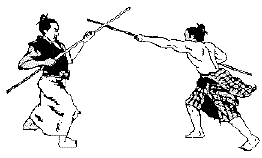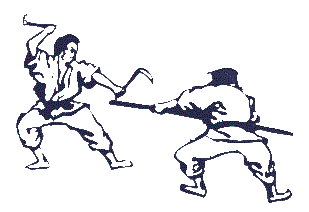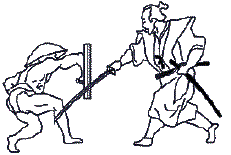
The Bo in Action
Kobudo
is the name used to refer to the ancient weapon arts of Okinawa and
Japan. Although Kobudo and Karate are separate arts, the two
are very closely related and many karate schools teach the use of
weapons. In fact, Okinawan Kobudo survives mainly
through its practice in karate schools like DeValentino Shudokan
Schools International (D.S.S.I.). Karate and Kobudo utilize
many of the same stances, movements, tactics, and principles.
Kobudo literally means "ancient martial way," and many of the weapons of Kobudo are indeed ancient. The weapons used in Okinawan Kobudo were mainly devised from agricultural tools, since the use and ownership of weapons was prohibited in the fifteenth century, along with the practice of all martial arts. The resourceful Okinawans made very effective use of common agricultural tools as deadly weapons, and practiced them as they did karate, in secrecy, for hundreds of years until the late 1800's when Japans feudal era ended and martial arts began to be practiced publicly. Although the use of these weapons became highly refined over several centuries, the art of karate was more common and became more refined, organized, and systematized, particularly in the nineteenth century, and by the time the veil of secrecy had been lifted from martial arts practice in Okinawa, karate was much more widely practiced. Unfortunately, the weapons arts of Okinawa became less popular as karate became more and more popular. In modern times, the use of weapons such as the ones practiced in Kobudo, had little practical value for self-defense purposes compared to the art of karate, and came to be practiced more for the preservation of the arts, and the development of mind, body, and spirit.

The Bo in Action
The D.S.S.I. kobudo system places great emphasis on the use of the bo, an implement said to be derived from the tenbib, which was a wooden staff that was slung across the shoulders in order to transport buckets of water on each end. The most popular type of bo is the rokushaku, which measures six feet in length and 1 1/4 inches thick at the center, tapering down to 3/4 inch at the ends. Other types of bo range in length from four to nine feet, and can be round (maru-bo), four-sided (kaku-bo), six-sided (rokkaku-bo), or eight-sided (hakkakubo). The most common bo kata are Choun-No-Kon, Sakugawa-No-Kon, and Tokumine-No-Kon. Other staff-type weapons include the hanbo (threefoot wooden stick), jo (four-foot wooden stick), tetsubo (Iron staff), sansetsu-kon (three-sectioned staff), and the konsaibo, which is a wooden staff studded with iron nubs.
Many traditional Okinawan kobudo weapons were developed to defend against opponents wielding spears or swords. Implements such as the sai, which is a three-pronged metal truncheon, were often used in sets of two or three for the purpose of entrapping an attacker's weapon and using the pronged ends in a jabbing, puncturing strike. Although the exact origin of the sai is obscure, it closely resembles an instrument that was used in China, and is also believed to have been derived from a farming implement that was used for digging furrows in the ground for planting seeds. A third sai was often carried behind the back in the belt sash (obi) as a replacement for a hand-held sai that was thrown at an opponent. The nunti is a three-pronged weapon that is sometimes incorrectly referred to as a manji-sai, with one of the outside prongs facing in the opposite direction, toward the handle, and which often attached to the end of a bo. Other truncheon weapons are the juste and the tokushu-keibo, a collapsible metal instrument.
The nunchaku is a weapon made from a horse bridle strap and a tool that was used to pound grain or rice. The most common types of nunchaku have octagonal (hakkakukei) or round (maru-gata) wooden handles of equal length connected by a length of rope or chain.

Kama vs. Bo
Sickles that became useful weapons for self-defense includes the kama, which has a curved blade, and the naginata, a curved blade, sickle-like spear seven feet in length. The nagemaki is a heavier version of the naginata with a larger blade, while the rokushaku-kama is a sickle with a six foot handle.
Wooden implements played an important role in the history of kobudo, and tools such as the tonfa (tuifa, tounkwa), which were used as grist mill handles, served as effective weapons. The eku (boat oar) was a popular item in Okinawan fishing villages, and has a unique feature in allowing the defender to fling sand in an attacker's face by holding the eku straight up with the paddle end down, and kicking the bottom out in a swift, forward and upward motion. There is also the abumi (wooden saddle stirrup) and the tatsuko ("knuckle-duster") made from yarn spindles.

Tonfa vs. Katana
Chizikanbo, made from wooden fish floats, is another weapon that is attached to the hands to aid punching effectiveness. The bokken, or wooden sword, was employed as a training device, while the kendo practice sword made of bamboo shoots (shinai) served as a conditioning implement.
Knife-like weapons that could be concealed within clothing and easily produced when needed are the kaiken (six- inch knife), juken (bayonet), and the tanto (dagger with a blade measuring eight to sixteen inches in length). Another device is the ninshokudai, or candles on an L-shaped, iron-spiked holder that was said to be carried by Okinawan women.
Chains produced large, heavier weapons such as the surushin (Manriki-gusari), which was weighted at one end, and the gekigan (ball and chain). The chigiriki is a weapon that has a three-to-ten-foot chain attached to an iron ball at one end and a staff at the other end. The nagegama is a retractable walking stick made from chain links.
Other items include the halberd, a heavy, axe-like weapon with a coin-shaped blade. The naginata, a sword-like weapon, similar to the European halberd or glaive. The tekko is another form of "brass knuckles," which is made of metal and studded. The tinbay (timbei, tembe, timpei), which is a shield made from the shell of a giant sea turtle, proved effective for repelling sword or spear attacks, and was often used with the small dart-like weapon known as rochin.
Kobudo has become very popular among
practitioners of the major Okinawan karate styles, as it fits in
well with empty-hand arts and rounds out a student's martial
training. One of the traditional Okinawan principles concerns the
fact that kobudo is viewed as not only an art for self-defense, but
also serves as a means of obtaining and maintaining inner peace.